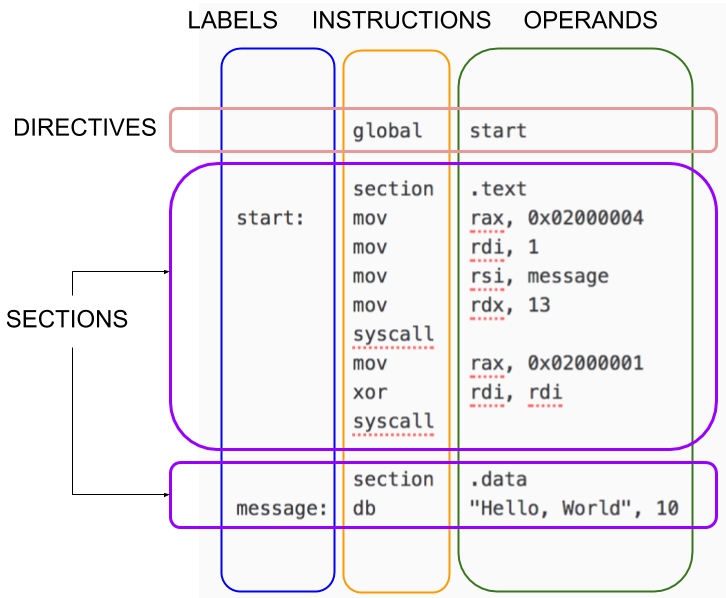Full X86_64 Instruction Set Reference Card
#GP(0)If a memory operand effective address is outside the CS, DS, ES, FS, or GS segment limit. (128-bit operations only) If a memory operand is not aligned on a 16-byte boundary, regardless of segment.#GP(0)If a memory operand effective address is outside the CS, DS, ES, FS, or GS segment limit. (128-bit operations only) If a memory operand is not aligned on a 16-byte boundary, regardless of segment.#SS(0)If a memory operand effective address is outside the SS segment limit.#UDIf EM in CR0 is set. (128-bit operations only) If OSFXSR in CR4 is 0. (128-bit operations only) If CPUID feature flag SSE2 is 0.#NMIf TS in CR0 is set.#MF(64-bit operations only) If there is a pending x87 FPU exception.#PF(fault-code)If a page fault occurs.Real-Address Mode Exceptions. #GP(0)(128-bit operations only) If a memory operand is not aligned on a 16-byte boundary, regardless of segment. If any part of the operand lies outside of the effective address space from 0 to FFFFH.#GP(0)(128-bit operations only) If a memory operand is not aligned on a 16-byte boundary, regardless of segment.

X86 32 bit opcodes that differ in x86-x64 or entirely removed. Intel's insn reference (follow the link in the x86 tag wiki, or ). They could have simplified things a lot, and made x86-64 a much better cleaner instruction set with more room for future extensions. The INT n instruction is the general mnemonic for executing a software-generated call to an interrupt handler. The INTO instruction is a special mnemonic for calling overflow exception (#OF), interrupt vector number 4. The overflow interrupt checks the OF flag in the EFLAGS register and calls the overflow interrupt handler if the OF flag is set.
If any part of the operand lies outside of the effective address space from 0 to FFFFH.#UDIf EM in CR0 is set. (128-bit operations only) If OSFXSR in CR4 is 0. (128-bit operations only) If CPUID feature flag SSE2 is 0.#NMIf TS in CR0 is set.Virtual-8086 Mode ExceptionsSame exceptions as in Real Address Mode.

I'm always surprised by how few asmers use probably the best source of information available – official processor manuals, either Intel's or AMD's. That's why this article was written. It should guide you step by step through complexity of Intel manuals, describing x86-64 architecture in the process.
X86 Instruction Set Pdf

Full X86_64 Instruction Set Reference Card Free
#GP(0)If a memory operand effective address is outside the CS, DS, ES, FS, or GS segment limit. (128-bit operations only) If a memory operand is not aligned on a 16-byte boundary, regardless of segment.#GP(0)If a memory operand effective address is outside the CS, DS, ES, FS, or GS segment limit. (128-bit operations only) If a memory operand is not aligned on a 16-byte boundary, regardless of segment.#SS(0)If a memory operand effective address is outside the SS segment limit.#UDIf EM in CR0 is set. (128-bit operations only) If OSFXSR in CR4 is 0. (128-bit operations only) If CPUID feature flag SSE2 is 0.#NMIf TS in CR0 is set.#MF(64-bit operations only) If there is a pending x87 FPU exception.#PF(fault-code)If a page fault occurs.Real-Address Mode Exceptions. #GP(0)(128-bit operations only) If a memory operand is not aligned on a 16-byte boundary, regardless of segment. If any part of the operand lies outside of the effective address space from 0 to FFFFH.#GP(0)(128-bit operations only) If a memory operand is not aligned on a 16-byte boundary, regardless of segment.
If any part of the operand lies outside of the effective address space from 0 to FFFFH.#UDIf EM in CR0 is set. (128-bit operations only) If OSFXSR in CR4 is 0. (128-bit operations only) If CPUID feature flag SSE2 is 0.#NMIf TS in CR0 is set.InstructionLatencyThroughputExecution UnitCPUID0F3n/0F2n/069n0F3n/0F2n/069n0F2nPMULHUW mm, mm9/8/-1/1/-FPMULPMULHUW xmm, xmm9/8/3+12/2/2FPMUL.